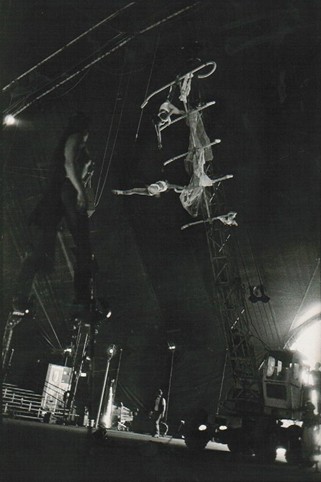Métal Clown
Métal Clown uses symbolism to retrace the history of slavery and the invasions by European pioneers and conquistadores. Instead of boats sailing the seas, however, the pioneers invade the road on semi-trailers, wild motorcycles, and other extravagant vehicles.
As Europe arrives, so does its motley crew... The conquistadores are the metal clowns.
This group of metal clowns is composed of performers who are hired in each city on the tour. Amidst the hundred performers from 13 different nations who make up the show’s troupe, these local actors represent the city. Meanwhile, the slaves and Brazilians are represented by a group of 18 dancers-musicians-capoeiristas from Bahia Axe Bahia.
Before the company arrives in a city, an 80-meter-long paved road is prepared. The big top (a huge tunnel) is erected above this road, and tiered seating is set up on either side. Two huge doors let in and out the semi-trailers and other machines that support the circus acts (for example, the trapeze truck).
© Philippe Cibille
© Philippe Cibille
© Philippe Cibille
© Philippe Cibille
© Philippe Cibille
© Philippe Cibille
Production Information
Authors: Pierrot Bidon and Guy Carrara
Director: Pierrot Bidon
Acting direction: Reynald Coulon
Choreography: Luiz Badaro
Sound design: Ivan Roussel
Lighting design: Sarah Sankey
Pyrotechnics: Pete Mountain
Music:
The Thunderdogs: Tony d’Anico (vocals), Gavin Griffiths (guitar), Spanerman (saxophone), Seaweed Lennox-Smith (synthesizer), Jonee Eel (drums), Gaby Tosti (bass), Paul Chousmer (sound engineer)
Dancers – musicians – capoeirists:
Bahia Axe Bahia: Luis Badaro, Edson Percusso, Barbara Ketu, Escura, Marcia Faleta, Zeze Araujo, Nilmar Brandao, Gilmar Cruz, Passoka de Bahia, Milton Nascimento, Asson Bispo, Agnaldo Lua, Jorginho Macaco, Fabio Nabriga, Orelha Bamba, Dominguinhos, Claudio Baltar
Circus artists: Jean Pierre Venet, Rockin’ Robinson, Antoinette Poulioglou, Abdou Salam Benslama, Youssef Benslama, Driss Benseddick, Gérard Clarté, Pierre Marie Baudras, Sean Bridges, Hector Cobo Plata, Laurent Desflèche, Ingela Hinas, Marie Seclet, Anna Rache de Andrade, Raquel Rache de Andrade, Germain Guillemot, Come Doerflinger, Jean-Antoine Veran, Fabrice Champion, Boris Arquier, Chris Axelsen, Christian Charasse, Jason Kovach, Hugh Thomas, Fred Touch
Metal clowns: 15 extras in each city
Classic car parade and motorcycle club: around 40 to 50 participants in each city
Media Coverage
“Métal Clown, the Archaos circus… The lunatics of the big top... a road... a stretch of asphalt... and the tent above it unfolds and closes like a gentle eyelid... After London and its abandoned electric factory on the banks of the Thames, Archaos stops in Paris at the Quai de la Gare... All the violence, the poetry, the cruelty, the outcry; all the metal, the scrap, the rubbish, the machines, the shiny fabrics, the beautiful raucous songs of life… Archaos reclaims them and bends them to give us a show... In five years, this band of ‘alternative’ hooligans has become the biggest company in Europe with ticket sales of 80 million francs and applause from Helsinki to Sydney, from Rio to Manchester… The smell of petrol and gunpowder. Torchlight. Highway noises. The army of metal clowns clad in corrugated iron shields, armed with chainsaws, sulfate guns, and flamethrowers, take on the dancers for two hours, backed by the wicked rock and roll of The Thunderdogs... And always capoeira. Up in the sky, from where tender soap bubbles fall, Ana and Raquel soar and sway, carefree and sensual, to music as beautiful as another life, just as Fabio, the child acrobat and thief, is massacred by the Death Squads... In London, Prince Charles went incognito to see the show on several occasions. Perhaps he was touched by the art-chaotic motto: ‘A life without danger is no life at all’...”
– Marie Muller, Le Nouvel Observateur, December 1991-January 1992
“Métal Clown: art, politics, and diversity... With Archaos, blood ties and the dynastic structure that cemented notions of apprenticeship in the past are no longer extolled... The pyramidal figure (the belief in verticality) fades away. On the contrary, what is advocated is the democratic horizontality of cross-fertilization. Moreover, the show’s politicalized scenography marks out the horizontal path and represents a street... This 80-meter-long tunnel is lined on both sides by an audience caught up in Métal Clown’s underlying Rousseau-esque philosophy. The show invokes a futuro-third-worldesque vision of social relations... The arrival of shows like Métal Clown proves that for Archaos, the introduction of social fables, or Indo-European legends for the Zingaro company, not only doesn’t abolish the laws of the circus arts, but revitalizes them. It’s as if we had to go through the matrix again to regenerate a practice in the process of sclerosis...”
– Yan Ciret, ‘Le globe et le cercle’, Théâtre aujourd’hui, 1998
“Archaos... One trend, the ‘poetic’, dominates while another, ‘the absurd’ is gaining ground. The Archaos circus seems to monopolize the aesthetics of the political tract.... The rock and live music, the Mad Max movie quote... The rhythm, often frenzied... and above all, a form of sarcastic humor that is in phase with the ideology of today’s youth... In Métal Clown, traditional artists in sequined leotards perform acrobatics you’d hardly expect to see in the nave of this secular cathedral, whose altar boys are clowns clad in corrugated iron or acrobats painted like Alice Cooper rockers. This incongruity is not, however, a satire, but a tribute from the new circus to the old, as well as an exhortation to mutual respect and intercultural dialogue...”
– Jean-Michel Guy, ‘La transfiguration du cirque’, Théâtre aujourd'hui, 1998





